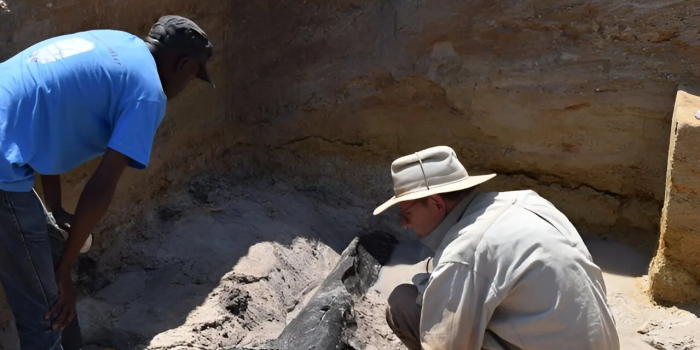In a groundbreaking archaeological revelation, evidence of ancient construction using wood has been unearthed, predating the emergence of our own species by nearly half a million years.
Archaeologists working at the Kalambo Falls site have made an astonishing find: two wooden logs meticulously joined together in a nearly cross-like configuration. The wood bears unmistakable markings from stone tools, indicating this structure’s deliberate shaping and crafting. While the exact purpose of this ancient wooden construction remains veiled in the mists of time, experts speculate that it might have served as a foundation for a platform or shelter, providing vital insights into the early lives of our distant relatives.

To establish the age of these structures, researchers employed a technique known as luminescence dating. This method allows scientists to determine the last exposure of a sample to sunlight, thereby estimating how long it has remained buried. The astonishing result yielded an age of approximately 476,000 years, firmly placing these wooden constructions within the early Stone Age epoch.
Remarkably, this discovery predates the existence of Homo sapiens as a species, which is believed to have evolved approximately 300,000 years ago. While the exact species responsible for these wooden structures remains a mystery, the region was inhabited by various ancestors and relatives of modern humans at the time, including Homo erectus and Homo heidelbergensis.

One of the key reasons why wooden remnants of this age are rare is the organic material’s natural susceptibility to decay. However, the archaeological site at Kalambo Falls has proven exceptional in preserving these ancient wooden artifacts, thanks in part to its high water levels.
This find challenges the conventional narrative of early human history in several ways. It has long been held that Stone Age humans were nomadic, adapting to different regions with changing seasons. However, the presence of constructed wooden structures suggests a potential shift towards settled communities. The Kalambo Falls area, with its stable water source and surrounding forests teeming with food resources, may have been an appealing locale for early human settlement.

Professor Larry Barham, corresponding author of the study, reflects on the significance of this discovery: “This find has changed how I think about our early ancestors. Look at what these people were doing: they made something new and large, from wood. They used their intelligence, imagination, and skills to create something they’d never seen before, something that had never previously existed. They transformed their surroundings to make life easier, even if it was only by making a platform to sit on by the river to do their daily chores. These folks were more like us than we thought.”
This monumental discovery, detailed in the journal Nature, reshapes our understanding of ancient human societies and highlights the ingenuity and resourcefulness of our distant forebears.
Source: University of Liverpool


